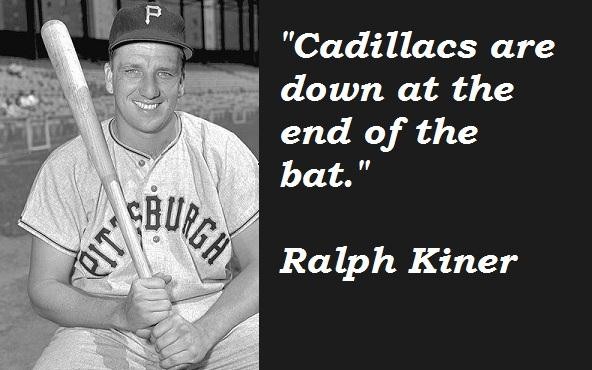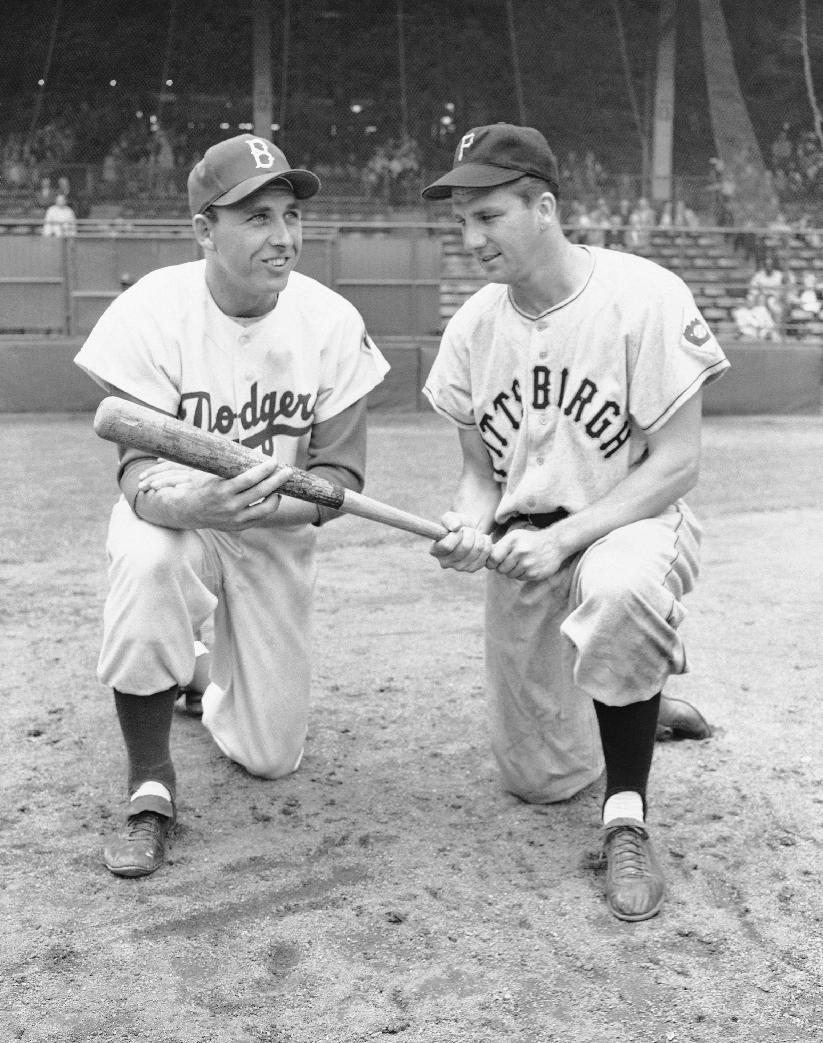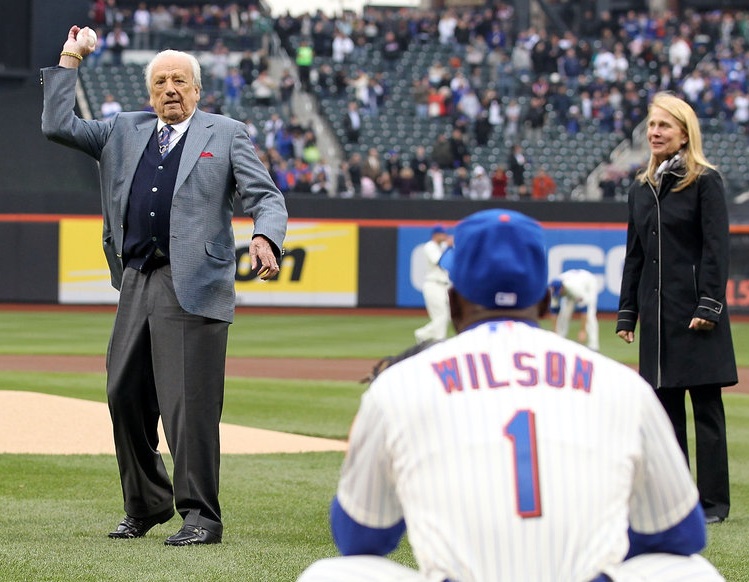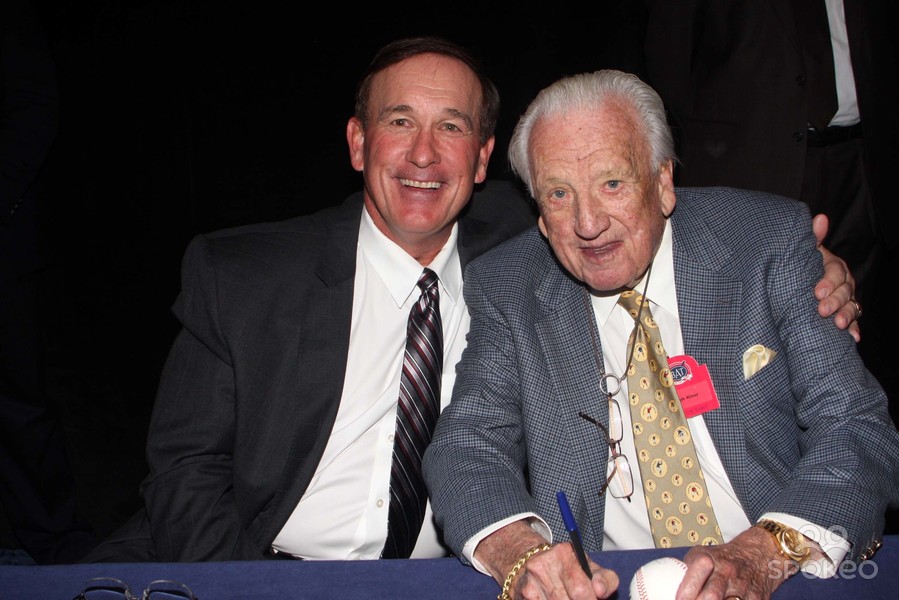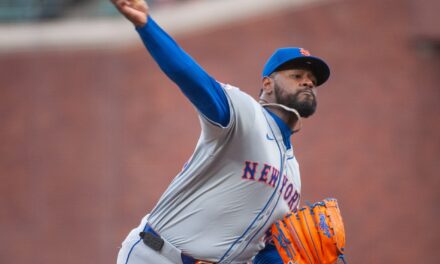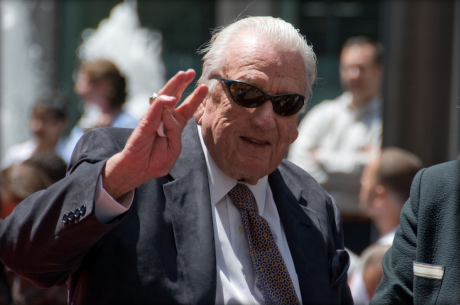
It was a part of the game. Tom Seaver would allow no runs and just 3 hits through 8 innings. Tug McGraw would strikeout the side in the 9th on just nine pitches for the save. Rusty Staub and Cleon Jones each got 3 hits, John Milner went deep, Buddy Harrelson made several diving stops and Jerry Grote threw out at least 3 or 4 base runners. Okay, okay, memories get embellished and exaggerated over time. But one thing remains a FACT.
No Mets victory was complete without Kiner’s Korner. It was a part of the game.
In 1973 I was 7 years old. The team I rooted for was 11 years old. There was no greatness associated with the blue and orange. Seaver would have a shot at Cooperstown but he wasn’t even 30 years old. To this young fan, the Mets only link to past prominence was through one of our broadcasters.
My father taught me baseball. But Ralph Kiner, Lindsey Nelson and Bob Murphy brought it into my home.
Ralph McPherran Kiner was born in Santa Rita, NM on October 27, 1922. His father died when he was 4 and his family relocated to Alhambra, CA. His minor league career was put on hold when he served as a Navy pilot during WW II. Ralph downplayed his military service. Upon returning stateside, when asked if he saw any action in the Pacific, he replied, “I didn’t even see any whales.”
The 1920’s had Ruth and Gehrig. The ‘30’s had Jimmie Foxx and Mel Ott. The ‘60’s would have Aaron, Mays and Killebrew. The 70’s belonged to Reggie Jackson and Mike Schmidt. But for the late 40’s and early 50’s there was no prolific HR hitter more feared and more respected than Ralph Kiner.
He made his debut with Pittsburgh on April 12, 1946. Had there been a Rookie of the Year back then Ralph likely would have won. His 23 HR’s led the league. He knocked in 81 for a team that finished seventh.
Despite his power, management was unhappy with his 109 whiffs, an exorbitant amount for that period. And so they had their 24 year old slugger work with legendary Hank Greenberg. The following year Kiner exploded. He hit 51 HR’s, good enough to lead all of Baseball while raising his BA nearly 70 points to 313.
Two years later, 1949, Kiner almost broke a record fans thought would stand forever. He ended the season with 54 HR’s, 6 short of Ruth’s mark and just 2 shy of the NL record. The 54 would remain most in the NL until the steroids era.
“Ralph can wipe out your lead with one swing of a bat.”—Warren Spahn
Ralph became the first player in NL history to reach the 50 HR mark twice. He led the league in HR’s 7 straight years. For 5 consecutive years (1947-1951) he topped 40 HR’s and 100 RBI’s, stats made more impressive when you take into account the fact the weak hitting Pirates rarely had men on base and no protection behind him. When the Pirates were losing badly, something they did a lot, fans would stay just to see one more AB by Kiner. He is one of only seven players in history to have four 30 HR/100 RBI seasons in his first five years. The left field porch at Forbes Field was dubbed Kiner’s Korner.
In June 1953, a salary dispute between Ralph and GM Branch Rickey came to a head. The best power hitter in the game wanted a raise from $75,000. What he got instead was traded to Chicago as part of a 10 player swap. Rickey famously told Ralph, “We finished last with you. We can finish last without you.” Ralph went deep 28 times and knocked in 87 in 117 games.
The following year, his power decreased due to irksome back injuries. It was bizarre. Whereas most players waited until Spring Training to get in shape, Ralph stayed fit and worked out all winter. He hit 285, but went deep only 22 times, the lowest total of his career. He was traded to Cleveland where he offered to take a 38% pay cut. He felt he didn’t deserve more.
The back injury worsened in 1955. He considered surgery but the operation only had a 50% success rate. A positive outcome would fully heal him. Failure would leave him paralyzed. Ralph had invested wisely, earned a lot doing what he loved. At age 32, after 10 seasons, he retired from Baseball with 369 HR’s, 1015 RBI’s, a 279 BA and 548 slugging average. His 7.1 HR/100 AB’s was second most in history, trailing only Ruth.
He became GM for the Indians AAA team and to save money decided to announce the games himself. After several years in San Diego and a brief stint in Chicago, Ralph headed east in 1962 where he became part of a new team called the Mets. Along with Lindsey Nelson and Bob Murphy, Ralph would become one-third of the longest broadcasting trio in history: 19 years.
Shortly after being hired at WOR Channel 9, in an interview Ralph expressed remorse about not breaking Ruth’s record of 60. He felt that his relatively brief career would go unappreciated and fade into history. And so he intended to stay with WOR as long as possible. He hoped his legacy off the field would supersede his career on the field. Ralph would stay part of the Mets team in one capacity or another for fifty three years, third longest stint with one club ever.
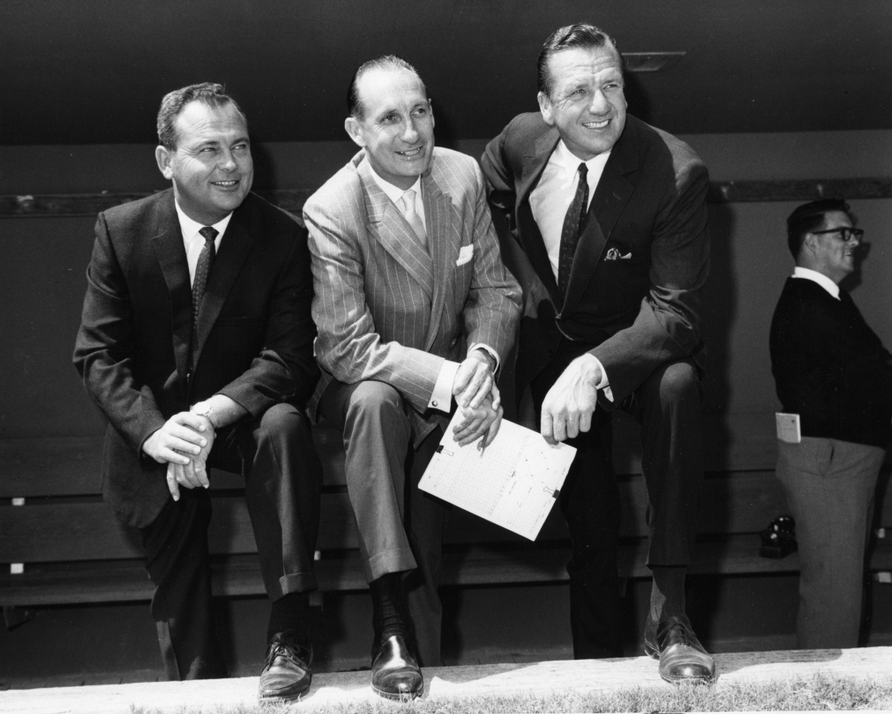
Like the team they broadcast, they were an eclectic bunch. Unusual. Lindsey Nelson’s multi-colored sport suits pushed the newfangled technology of color TV to its breaking point. His play-by-play was as smooth as silk, fluent. He seemingly never made a mistake. Bob Murphy was an artist, painting pictures with words and with the eloquent cadence of a master.
And then…there was Ralph.
On the field, he was one of the best. Behind the microphone, he was…well, he was Ralph. He had immense knowledge of the game, mesmerizing personal stories. He explained the art of hitting in simple yet entertaining terms that any young fan could comprehend. Ralph Kiner knew how to play Baseball. He knew how to discuss Baseball. But sometimes, his words came out differently than they sounded in his mind. He was Yogi Berra of the booth. His malapropisms were legendary, humorous and laugh-out-loud funny at times. You listened to Lindsey to enjoy the game, Bob to relish an enjoyable afternoon. But Ralph? You listened extra closely, just to see what he’d mess up next.
But we didn’t care. We treasured Ralph and for his foibles, faults and mistakes, he was lovable. Just like the Mets. He wasn’t as refined as his colleagues. Not even close. But that made him more real, more down to earth. One of us. He made the game personal and friendly. Ironically, it was this least polished of the trio who produced the most memorable in-game play by play catchphrase: That ball is going going, gone, goodbye.
He once referred to catcher Gary Carter as Gary Cooper. He called his sidekick Tim MacArthur instead of Tim McCarver. And there were others. Many many others.
On Father’s Day, we wish you fathers all a Happy Birthday.
If Casey Stengel were alive today, he’d be spinning in his grave.
The Hall of Fame ceremonies this year will be held on the 31st and 32nd of July.
Tony Gwynn was named Player of the Year for April.
Kevin McReynolds stops at third. And he scores.
The Mets have gotten their lead-off batter on only once this inning.
Darryl Strawberry has been voted to the Hall of Fame five years in a row.
Mazzilli goes back, goes back, his head hits the wall. And it’s rolling toward left field.
Good afternoon. Thanks for tuning in to Kiner’s Korner. I’m Ralph Korner.
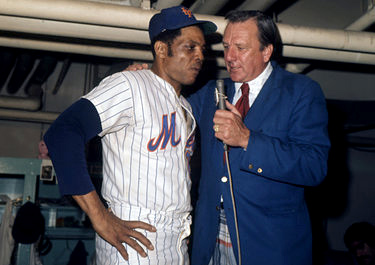
Kiner’s Korner was the icing on the cake after a home victory. For fifteen minutes, Ralph would chat with the star pitcher or big hitter from that game. They’d replay at-bats pitch by pitch, discuss a big catch or why the pitcher threw a 2-2 curve ball.
It was a different time. We didn’t get canned answers from players sitting in front of their locker with a bank of cameras and microphones surrounding them. Unlike so-called ‘sports reporters’ nowadays, Ralph didn’t rephrase the same question nine different ways. There was no gotcha journalism. He wasn’t looking for a sound bite. He was talking Baseball, a dialogue between one of the all-time greats and that day’s star.
Kiner’s Korner was unscripted. And that made it real. You weren’t watching a TV program but rather eavesdropping on a conversation in your living room between Ralph and Jerry Koosman.
Tom Seaver would discuss the art of pitching, sometimes emitting that unforgettable Seaver laugh. Cleon Jones would sit there and mostly give one word answers, never comfortable in the spotlight. Rusty Staub was the consummate professional. Tug McGraw would display that broad smile. Felix Millan never got a follow-up question because…it seemed like Ralph was always thrown off by Millan’s heavy accent.
But even Kiner’s Korner got off to a dubious start. Shortly after it became a regular post-game feature following a Mets win, Ralph interviewed manager Casey Stengel. After the live broadcast ended, Stengel shook hands with Ralph, stood and departed back to the locker room. However, Casey forgot he was hooked to a mic and as he walked away the wires and such tangled, collapsing the cardboard walls that served as a backdrop and destroying the makeshift set.
In 1996, Ralph announced he was suffering Bell’s Palsy. His speech was slurred and as years passed, it became somewhat difficult to understand him. Almost painful. But again, we didn’t care. Ralph was one of us. Howie Rose stated yesterday, “Ralph was royalty. And you don’t throw the king overboard until he’s done.”
Ralph Kiner was 91 years old when he slipped away Thursday. He leaves behind five children and twelve grandchildren. His number 4 was retired by the Pirates. A statue of him stands in Alhambra. He was an RBI champion, 6-time All-Star, 7-time NL HR King. He is a Hall of Famer. He was the best hitter in the game for nearly a decade. Loved by fans, admired by teammates, feared yet respected by those competing against him. He’d been with our team since 1962, a true original Met. He was funny, personable, entertaining, intelligent. He spent more than 70 years doing what he loved. And in spite of his self-doubt, his legacy does live on. He’s now reunited with the other two members of the Mets original broadcast team, talking Baseball and catching up. Baseball historian Marty Noble called him, “One of Baseball’s genuine and most charming gentlemen.”
But to us, he’ll always be Ralph.

